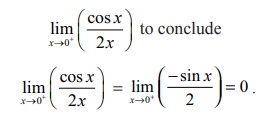Applications of Differential Calculus | Mathematics - Indeterminate Forms | 12th Maths : UNIT 7 : Applications of Differential Calculus
Chapter: 12th Maths : UNIT 7 : Applications of Differential Calculus
Indeterminate Forms
Indeterminate
Forms
In this
section, we shall discuss various ŌĆ£indeterminate formsŌĆØ and methods of
evaluating the limits when we come across them.
A Limit Process
While
computing the limits

lim xŌåÆ╬▒ R(x)
of
certain functions R( x) , we may come across the following
situations like,

We say
that they have the form of a number. But values cannot be assigned to them in a
way that is consistent with the usual rules of addition and mutiplication of
numbers. We call these expressions indeterminate forms. Although they are not
numbers, these indeterminate forms play a useful role in the limiting behaviour
of a function.
John
(Johann) Bernoulli discovered a rule using derivatives to compute the limits of
fractions whose numerators and denominators both approach zero or Ōł×.
The rule is known today as lŌĆÖH├┤pitalŌĆÖs Rule (pronounced as Lho pi tal Rule),
named after Guillaume de lŌĆÖHospitalŌĆÖs, a French nobleman who wrote the earliest
introductory differential calculus text, where the rule first appeared in
print.
The lŌĆÖH├┤pitalŌĆÖs Rule
Suppose f ( x)
and g ( x) are differentiable functions and g(xŌĆ▓) ŌēĀ 0 with

Indeterminate forms 0/0, Ōł×/Ōł×, 0├ŚŌł×, Ōł×-Ōł×
Example 7.33

Solution
If we
put directly x =
1 we observe that the given function is in an indeterminate form 0/0. As the numerator
and the denominator functions are polynomials of degree 2 they both are
differentiable. Hence, by an application of the lŌĆÖH├┤pital Rule, we get

Note
that this limit may also be evaluated through the factorization of the
numerator and denominator as

Example 7.34

Solution
If we
put directly x =a we observe that the
given function is in an indeterminate form 0/0 . As the numerator and the
denominator functions are polynomials they both are differentiable.
Hence by
an application of the lŌĆÖH├┤pital Rule we get,

Example 7.35

Solution
If we
directly substitute x =
0 we get an indeterminate form 0/0 and
hence we apply the lŌĆÖH├┤pitalŌĆÖs rule to evaluate the limit as,

The next
example tells that the limit does not exist.
Example 7.36

Solution
If we
directly substitute x =
0 we get an indeterminate form 0/0 and hence we apply the lŌĆÖH├┤pitalŌĆÖs rule to
evaluate the limit as,

As the
left limit and the right limit are not the same we conclude that the limit does
not exist.
Remark
One may be tempted to use the lŌĆÖH├┤pitalŌĆÖs rule once again in

which is
not true because it was not an indeterminate form.
Example 7.37

Solution
As this
is an indeterminate form (0/0), using the lŌĆÖH├┤pitalŌĆÖs Rule

Now
using the example 7.35, we have

Example 7.38

Solution
This is
an indeterminate form Ōł×/Ōł× and hence we use the lŌĆÖH├┤pitalŌĆÖs Rule to evaluate the
limit.

Example 7.39

Solution
This is
an indeterminate of the form Ōł× ŌłÆ Ōł× . To evaluate this limit we first
simplify and bring it in the form (0/0) and applying the lŌĆÖH├┤pital Rule, we get

Example 7.40
Evaluate
: 
Solution
This is
an indeterminate of the form (0 ├Ś Ōł×) . To evaluate this limit, we first
simplify and bring it to the form (Ōł×/Ōł×) and apply lŌĆÖH├┤pital Rule. Thus, we get

Example 7.41

Solution
This is
an indeterminate of the form (Ōł×/Ōł×) . To evaluate this limit, we apply
lŌĆÖH├┤pital Rule.

Example 7.42

Solution
This is
an indeterminate of the form (Ōł×/Ōł×).
To
evaluate this limit, we apply lŌĆÖH├┤pital Rule m times.
Thus, we have
limxŌåÆŌł×
ex/xm = limxŌåÆŌł× ex/m!
= Ōł× .

Indeterminate forms 00,1Ōł× and Ōł×0
In order
to evaluate the indeterminate forms like this, we shall first state the theorem
on the limit of a composite function.
Theorem 7.6
Let limxŌåÆ╬▒ g ( x) exist and let it be L and let f (x) be a continuous function at x = L . Then,

The evaluation procedure for evaluating the limits
(1) Let A = limxŌåÆ╬▒ g(x)
. Then taking logarithm, with the assumption that A > 0 to ensure the continuity of the
logarithm function, we get log A =
limxŌåÆ╬▒ log(g(x)) . Therefore using the above theorem
with f (x) = log x we have the limit

(2) We
have the limit lim xŌåÆ╬▒ log(g
( x)) into either (0/0) or (Ōł×/Ōł×) form evaluate it using lŌĆÖH├┤pital Rule.
(3) Let
that evaluated limit be say ╬▒
. Then the required limit is e╬▒ .
Example 7.43
Using
the lŌĆÖH├┤pital Rule, prove that limxŌåÆ╬▒ (1+
x )1/x = e
.
Solution
This is
an indeterminate of the form 1Ōł× . Let g ( x) =
(1+
x)1/x. Taking the logarithm, we get



Related Topics